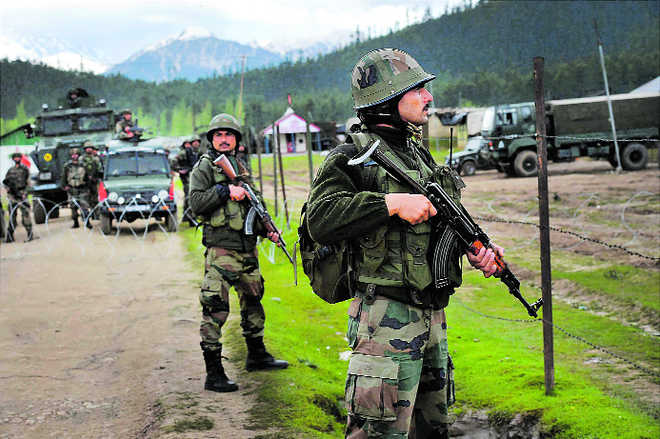In a step to improve survivability of Indian Army troops fighting against armed terrorists or guarding the Line of Control (LoC), the first lot of 10,000 light-weight bullet-proof helmets arrived in May-end. The final trials for new-age modular bullet-proof jacket is on, separately another 50,000 such jackets have been purchased using the financial powers available with the Army headquarters.
The Army is now pushing for a standard rifle that will be 7.62 calibre, firing 51mm ammunition (bullets) to replace the existing INSAS (Indian Small Arms System) rifle a 5.56 calibre which was designed some three decades ago. Some developments have taken place on this front which is no more than ‘half-steps’ while the decision awaits the policy nod.
“The existing INSAS rifle should have been replaced long ago, it does not inspire confidence among troops,” says Lt Gen Vinod Bhatia (retd), a former Director General Military Operations (DGMO).
The all-important helmets
A total of 1.58 lakh such helmets are being procured for about Rs 170 crore. “Deliveries have commenced and the first batch of 10,000 has come in,” a senior serving officer confirmed. The helmets are designed to bear the impact of 9mm ammunition fired from a short range which is equal to standard protection among leading armed forces.
As of now Army soldiers, wear a bulletproof “patka’— a modified round moulded headgear — that can only give protection on forehead and back of the head. It weighs around 2. 5kg.
Kanpur-based Indian company, MKU Industries, has been contracted and given three years to supply the new-age helmets. These can be fitted with radio to provide situational awareness and also night sights. The same will be used in any future wars and counter insurgencies. “Modernisation is a continuous process. Such new items add to the potential of the soldier,” says Lt Gen Gurmit Singh (retd), who once headed the Srinagar-based 15 Corps
Bullet-proof jackets
Despite numerous efforts in the past decade, the Army faces a shortage of bullet-proof jackets — a mandatory requirement to saves lives in counter-insurgency operations. In March 2016, 50,000 BP jackets were ordered for
Rs 140 crore as an emergency measure and the first batch of some 20,000 was received by the Army in October. The rest of these are coming in batches.
The Indian Army needs 3,53,765 new BP jackets sanctioned as per the plan of 2009. Off these, 1.86 lakh jackets were to be supplied in the 11th plan (2007-2012) and another 1.67 lakh jackets were to be supplied during the 12th plan (2012-2017). With the 12th plan having ended in March 2017, the only 50,000 have been ordered and these jackets are based on old specifications of the Army and not the modern light weight modular ones needed to allow greater agility to troops while protecting the head, neck, chest, groin and sides of the infantry soldiers.
New Rifle to replace INSAS
The most reliable weapon of an infantry or a paramilitary soldier is a good self-loading rifle that can fire with accuracy.
India now stands on the cusp of a policy decision that is to have an indigenous produced weapon or have a proven foreign weapon made in India. A global hunt is on to buy 185,000 7.62x51mm-calibre assault rifle and it will cost almost $1 billion.
The forces have so far not accepted the ‘Excalibur’ rifle being made by the Ordnance Factory Board (OFB) which is an upgrade of the INSAS. The OFB has made eight such pieces which are being tested by the Army. “ The OFB is not a weapon developer, its producer of weapons,” warns Lt Gen Bhatia on seeing too much into the new gun. A global request for information (RFI) was issued in June last year and it contains modified requirements, including the facility of a detachable 40 mm under-barrel grenade launcher and holographic sights allowing a sniper-shot.
The broad parameters specify the lightweight rifle should have a minimum effective or kill range of 500 metres with limited recoil. The Army wants the rifle to be compatible with eye-visible laser-target pointers, holographic and other sights, and the rifle should have a design, metallurgy and performance parameters to remain relevant for at least the next 25 years.
In the meanwhile, Israel Weapon Industries (IWI) has set up a joint venture with an Indian partner, Punj Lloyd, to manufacture small arms, including assault rifles. The plant, in Madhya Pradesh, was opened in May this year.
Unlock Exclusive Insights with The Tribune Premium
Take your experience further with Premium access.
Thought-provoking Opinions, Expert Analysis, In-depth Insights and other Member Only Benefits
Already a Member? Sign In Now










